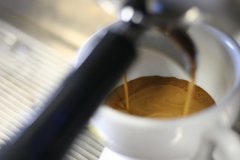Introduction of four kinds of coffee commonly used in cafes
Esprssso Italian style is very strong.
Espresso is an Italian word that refers to a strong coffee that is rapidly extracted by a coffee machine in a short period of time. It is the basis of almost all fancy coffee and a must-have in cafes all over the world. Espresso is a very small cup, usually only about 30 milliliters, the taste is very bitter, the surface is floating with a thick layer of oil, will be with a cup of water, you can choose to add sugar. Guests who order Espresso in a cafe are either real coffee lovers who want to taste the most authentic taste of coffee, or simply because they are extremely sleepy and in urgent need of refreshing.
People who want to spend a leisurely afternoon in a cafe are not very suitable for this. The Esprssso of some cafes can choose "Single single" or "Double double". Double does not mean two cups, but means to extract with double coffee powder, which will be more bitter.
Americano American Coffee
The "coffee of the day" in many cafes is actually American coffee, which is usually the cheapest on the cafe menu. To put it bluntly, American coffee is a small cup of Esprssso mixed with more than half a cup of boiled water, and some cafes use drip coffee pots. American coffee is light in taste, light in color, slightly sour and slightly bitter, and usually serves milk and sugar in cafes. If the waiter gives you cream, you might as well ask for fresh milk.
Caf é Latte latte
Latte is a classic mixture of Espresso and milk. A small amount of Espresso is poured into the bottom of the cup, and then a lot of milk is added. The top of the latte is a thick layer of foam. Skilled baristas will pull out a variety of patterns on the foam. There is a kind of "Ole coffee" in France, which is almost a national drink, much like a latte, except that milk and coffee are poured into the cup at the same time. Lattes are very popular in Chinese cafes with moderate prices and high performance-to-price ratio. A good latte has a good taste of coffee and milk, while a bad one may be like drinking a cup of hot milk with coffee flavor.
Cappuccino cappuccino
Once upon a time, Xiao Yaxuan's song "Cappuccino" was popular all over the country, and the sentence "Love is like Cappuccino, thick nostalgia foam" in the lyrics made everyone know the characteristics of this kind of coffee-foam. Cappuccino and latte have the same ingredients as Espresso+ milk + milk foam, except that there are more cappuccino milk bubbles than milk, and lattes have more milk than milk bubbles. Cappuccinos of the same price are usually smaller than lattes, but the coffee is more intense. The collision of dense milk foam and bitter coffee is also loved by a large number of customers, especially girls.
Caf é Mocha mocha coffee
The ingredients of mocha are relatively complex. On the basis of Espresso and milk, there is chocolate sauce, not foam at the top, but whipped cream, often squeezed with chocolate sauce, or sprinkled with cocoa powder and cinnamon powder to have a special flavor. Because "rich in content", the price is usually higher, but also relatively large cups. Both chocolate and cream taste sweet, so mocha coffee is an example of the combination of bitterness and sweetness.
Macchiato Macchiato
Macchiato is also translated by many cafes as "Macchiato", which simply means scooping a few spoonfuls of milk foam into a cup of Espresso. The coffee is still strong, and you can enjoy the fine and greasy milk foam. We often hear "caramel macchiato", which is said to be original by adding vanilla syrup to the milk, mixing it with Espresso coffee, and then covering the milk foam with a layer of caramel.
Important Notice :
前街咖啡 FrontStreet Coffee has moved to new addredd:
FrontStreet Coffee Address: 315,Donghua East Road,GuangZhou
Tel:020 38364473
- Prev

The importance of bean grinder to ESP
First of all, the average grinding of a coffee bean can divide a coffee bean into several kinds (some studies suggest that there are about 3 kinds of particles). The number of particles depends on the roughness of the grinding; on the contrary, uneven grinding divides a coffee bean into many different sizes.
- Next

The perfect espresso depends on 4 M's.
The first is Mistura, which means a combination of coffee bean types. In Italy, espresso coffee beans must be a combination of at least five coffee beans. The coffee bar master must be aware of the combination of coffee beans he uses. This is to find out what the espresso you brew tastes like. Deep understanding of coffee beans, in order to clear to the guests
Related
- Beginners will see the "Coffee pull flower" guide!
- What is the difference between ice blog purified milk and ordinary milk coffee?
- Why is the Philippines the largest producer of crops in Liberia?
- For coffee extraction, should the fine powder be retained?
- How does extracted espresso fill pressed powder? How much strength does it take to press the powder?
- How to make jasmine cold extract coffee? Is the jasmine + latte good?
- Will this little toy really make the coffee taste better? How does Lily Drip affect coffee extraction?
- Will the action of slapping the filter cup also affect coffee extraction?
- What's the difference between powder-to-water ratio and powder-to-liquid ratio?
- What is the Ethiopian local species? What does it have to do with Heirloom native species?

